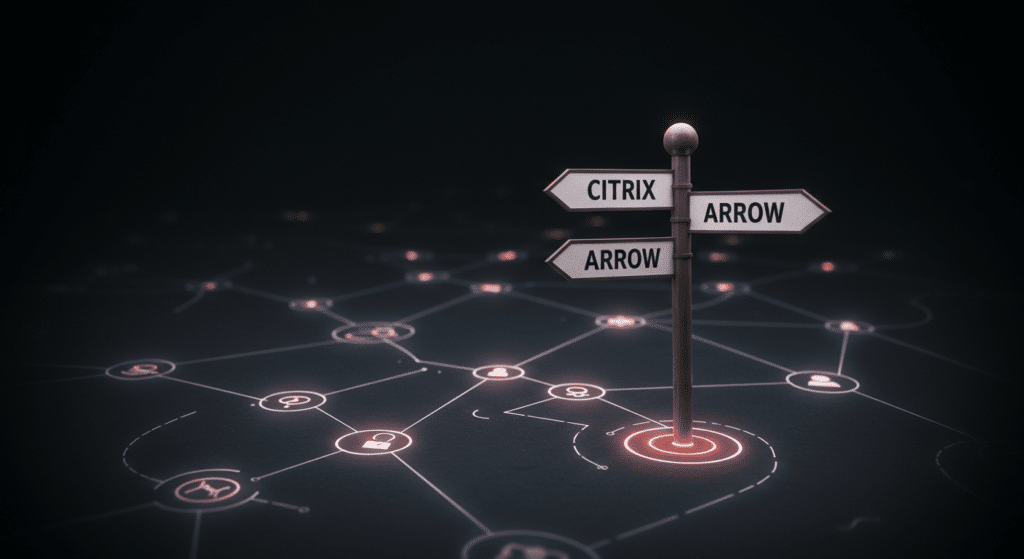
In this article, I am going to discuss what Citrix outsourcing their sales and support to Arrow means for their customers, and the negative impact that will likely have. But before I do, I just want to start by underlining what was announced and what the relationship between the two companies currently looks like.
The Citrix Solutions and Arrow Partnership
As we already know, Citrix is a vendor, and a company known for virtualization, networking, and cloud services focused on delivering end-user computing, whereas Arrow Electronics is one of the leading distributors of tech solutions.
As a business unit within the Cloud Software Group, Citrix’s strategic initiatives include forming exclusive distribution agreements and enhancing support for mid-market and small business customers through partnerships with distributors.
So now outsourcing sales and support to Arrow will mean that Arrow will front all sales and support activities for those customers that Citrix will no longer service. And there are a lot of customers that this is going to affect given that Citrix claims to have over 400,000 customers and they are only going to deal directly with the top 2,000 customers.
What Was the Agreement and What Does It Mean?
The agreement, announced on January 16, 2025, outlined a new strategic mid-market and sole distributor agreement with Arrow, coming into force on March 3, 2025. From this date forward, Arrow will assume responsibility for exclusively servicing the Citrix mid-market and SMB business in North America and Europe. Then from June 2, 2025, Arrow will also serve as the sole Citrix distributor for all channel partners in North America and Europe.
Arrow will assist service provider channel partners with managing their Citrix licenses, enhancing support, and streamlining processes.
As we already know, Citrix has gone through several rounds of layoffs, which are still seemingly ongoing even today, so this outsourcing could be seen as potentially helping with those cost cuts and help to streamline operations. However, typically this will be an exercise in ensuring the shareholders are kept happy!
But this does place a huge expectation on the distributor and their expertise, which to date is untested. Key to all this is how does that affect customers? Maybe there are pros and cons here. But both come at the expense of customer and partner experience.
Impact on Sales
Let’s break that down. Firstly, sales and support are two different areas, so let’s start with the sales side. If sales are outsourced, customers, in this case, the partners, will interact directly with Arrow’s sales teams instead of the Citrix sales teams. Potentially, Arrow could have a much broader reach or more localized presence, which could be seen as a bonus, but what about the expertise and knowledge? Do they have that?
The risk here is that they will not have the same specialized level of knowledge you would get when working directly with the vendor. There is going to be a steep learning curve to transfer that knowledge and experience and in the meantime that will have an immediate effect on customers, and there is no getting around that.
Impact on Channel Partner Support Teams

For support, when Arrow takes over, end-user customers will have to use a different process for logging support tickets. Typically, a support call would be placed directly on the vendor to manage through to resolution. In this case, Citrix. But now that support call will need to be raised on Arrow.
End-user customers don’t typically talk to or have a relationship with distribution, so does that mean end-user customers have to raise a support call with the reseller partner first? Or will Arrow have a completely new support process? This will cause delays in support calls being resolved in a timely manner.
Arrow’s global channels will have to facilitate a tailored support and streamline processes for Citrix customers, ensuring a more efficient and effective support experience. But this will take time to implement.
Again, there is the question of Arrow having the same level of knowledge and expertise as the vendor? Citrix will have to train Arrow’s support staff, and there could be a transition period where support quality dips while Arrow gets up to speed.
And then there is the question of escalation. What do Arrow have in place when they can’t help solve a customer issue? Back support calls off to Citrix? In the event of a bug needing to be raised how are Arrow going to deal with this as they won’t have access to internal systems or any code.
Potential Customer Challenges
All of this will affect existing contracts or relationships. If a customer was used to dealing directly with Citrix, now they have to go through Arrow. That could lead to confusion or frustration if the transition isn’t smooth, especially as end-user customers don’t typically have a relationship with distribution.
In the official announcement from both companies, Citrix says this move allows them to focus on product development, while Arrow emphasizes their capability to scale and provide a better level of service.
Regardless of this, it is the end-user customer that matters, and they won’t be concerned about either of these points. All that they will be concerned about is whether their specific needs will still be met, especially if they have complex setups or enterprise-level agreements. And of course, the licensing costs.
The Risks Involved
Of course, this isn’t the first time, nor will it be the last, where vendors outsource to partners. In those cases, sometimes it works well if the partner is competent, but other times customers feel neglected. So, the key factors here are communication during the transition, training of Arrow’s staff, and maintaining service quality levels and customer satisfaction.
Risks could be possible delays in support responsiveness, a less personalized service, confusion during transition, and risk of miscommunication between Arrow and Citrix with some potential finger-pointing. None of which is good for customers.
The Pricing Factor of Citrix Licenses
The one thing we haven’t talked about yet is pricing. This again is going to be under the microscope, especially given recent licensing and renewal costs being much higher than customers were expecting.
Arrow could potentially have different pricing structures or bundles, meaning that customers might need to renegotiate contracts or adapt to new purchasing systems, which leads us onto how that purchasing mechanism works.
The Impact on Purchasing Channels

Currently, customers purchase Citrix via a reseller channel partner, who in turn buy from distribution. It’s the tried and tested three-tier channel model. As Citrix used to work with other distributors or partners, how does this exclusivity with Arrow affect them?
Maybe some partners lose access and no longer qualify to be Citrix resellers, which could impact customers who worked through those channels. Does it mean Arrow can charge what they like given they are the only game in town when it comes to purchasing Citrix?
Conclusion
While the partnership could enhance Citrix’s operational focus and customer reach through Arrow’s distribution strengths, the transition’s success hinges on seamless execution, transparent communication, and sustained service quality.
Customers should remain vigilant, adapt processes as needed, and leverage Arrow’s potential synergies for long-term benefits. On the other hand, this could be yet another reason for customers to seek alternative solutions.
Apporto is that alternative solution.
With a proven track record of delivering lower pricing (no more paying for bundles with features never to be used), lower complexity (simple containerized deployment), but with all the features and performance customers have come to expect delivered directly to the browser.
Apporto is not just about the tech, it’s all about putting the customer first too and this is set out in the Apporto Customer Bill of Rights which reflects our commitment to fairness, transparency, and customer satisfaction that ensures fair pricing, flexible purchases, and clear communication.


